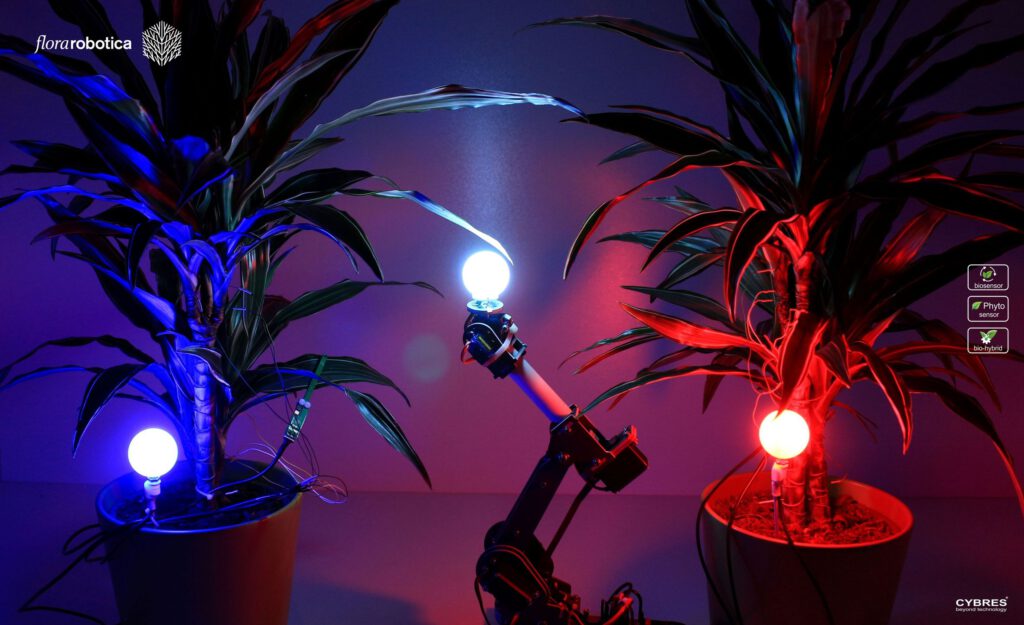Phytosensing and phytoactuating system

The phytosensor measures physiological and electrophysiological parameters of plants (productive and domestic plants, herbs, shrubs, trees). In addition to phytosensing, the device can perform phytoactuation, i.e. control light, irrigation or fertilization. The combination of phytosensing and phytoactuation allows not only to monitor the physiological state of plants in real time, but also to enable biological organisms to control environmental parameters, optimize growth conditions or cope with stress factors. Phytoactuation based on biofeedback is the next step in the development of hydroponics, vertical farming and controlled environment agriculture.
The system measures (depends on electrodes):
- Biopotentials, 2 channels
- Tissue impedance (leaf and stem fluid content), 2 channels
- Electrochemical impedance spectroscopy (ionic analysis of tissues)
- Leaf transpiration, leaf temperature, single channel
- Stem’s sap flow, electrochemical and heat-impulse/balance (optional)
- Soil moisture and temperature (optional)
- Environmental parameters: 3D accelerometer/magnetometer, EM power meter, air temperature and humidity, pressure, light (on external sensor panel)
- Supported external sensors: CO2, O2, ion-selective electrodes, any sensors with analog or I2C interface
- Impedance measurements can conduct a micro-current stimulation (2 channels)
- Real-time regression/spectral/correlation/statistical analysis is available for all measurements.
Actuation (control of external devices, with power management system):
- 6 solid state/ electromechanical relays, high power MOSFETs
- 220V/110V actuation for light (full spectra, far-red, UV)
- 12V/24V for irrigation (pumps or solenoids)
- Water/air preparation, e.g. pH control, adding fertilizers, ozonation/AOP (advanced oxidation process), aeration/OMB (O2 microbubbles), magnetic treatment
Applications
- professional plant cultivation
- vertical/indoor farms, controlled environment agriculture
- biofeedback-based growth
- bio-sensing and phyto-sensing systems
- plant enthusiasts, entertainment/art systems with plants
Additional components
- mini-PC (Win 10 Pro, J4125, 8G 128G, HDMI 4K, BT4.2, 2.4G/5.8G Wi-Fi, USB3.0)
- power management module (220V/110V, 12/24V outputs)
- available electrodes: 1) electrophysiology – biopotintials 2x, tissue impedance 2x; 2) all sensors (soil sensors optional)
Manuals, application notes, publications
- CYBRES Measurement Unit MU3: SHORT MANUAL (English, German, French, Ukrainian, Arabic, Chinese)
- CYBRES EIS for electrochemical and electrophysiological analysis of fluids and organic tissues: EXTENDED USER MANUAL
- Application Note 28. Using phytosensor in precision agriculture, vertical farms, hydroponics and agricultural AI applications
- H. Hamann et al, “Flora robotica – Mixed Societies of Symbiotic Robot-Plant Bio-Hybrids”, IEEE Symposium on Artificial Life (IEEE ALIFE’15), 2015
- Device for measuring the plant electrophysiology, IJUS, Issue 12-13(4), p.138, 2016
- H. Hamann et al, “Flora robotica–An Architectural System Combining Living Natural Plants and Distributed Robots”, arXiv:1709.04291, 2017
- M. Wahby et al, “Autonomously Shaping Natural Climbing Plants: A Bio-hybrid Approach” Royal Society Open Science, 2018
- H. Hamann et al, WatchPlant : Networked Bio-hybrid Systems for Pollution Monitoring of Urban Areas, ALIFE 2021, MIT Press, pp. 118-126, 2021 doi: 10.1162/isal_a_00377
- L. García-Carmona et al, .“Biohybrid systems for environmental intelligence on living plants”, 2021. GoodIT ’21, p. 210–215, 2021, doi: 10.1145/3462203.3475885
- S.Kernbach, Device for measuring the plant physiology and electrophysiology, arXiv:2206.10459v1, 2022
- E.Buss, et al, Stimulus classification with electrical potential and impedance of living plants, Bioinspir. Biomim. 18 025003, 2023, DOI 10.1088/1748-3190/acbad2
- S.Kernbach, Biofeedback-Based Closed-Loop Phytoactuation in Vertical Farming and Controlled-Environment Agriculture. Biomimetics 2024, 9, 640, doi: 10.3390/biomimetics9100640
Video

